Highlights of the Collection
Opening in September 2020, Further Impressions, an exhibition highlighting our best acquisitions from 2005 to 2020 will be on display in our ground floor exhibition hall. See Upcoming Exhibitions for more information. A selection of over 250 highlights from the Grolier Club Library can be found in our catalogue, Lasting Impressions: The Grolier Club Library, published to accompany the exhibition held at the Club May 11-July 31, 2004. The contents of this catalogue can be viewed on the Grolier Club online exhibitions page. We have selected a few of our favorites below. Other highlights may be seen on the "Guide to Collections" section of this website.
BIBLIOGRAPHY
General Bibliography/Liberty of the Press/Bookselling/Book Auctions/Institutional Libraries/Private Libraries
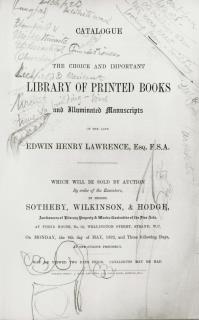 |
William Morris at Auction. Book auction catalogues annotated by William Morris and Sir
Sydney Cockerell, 1892-1895. A close look at the doodles in this volume of six
auction catalogues reveals the penciled sketches, marks, and comments of
William Morris (1834-1896). The lots Morris marked made their way into his
library, where they influenced his decorative designs for Morris
& Co. and the books he produced at the Kelmscott Press.
|
|
Bodleian Library. Thomas Hyde's 1674 catalogue of the printed books in the Bodleian Library served as a valuable reference work for scholars for many years. The Grolier Club copy is heavily annotated by Sir George Fleming (1667-1747), later Bishop of Carlisle, who inscribed additional titles and shelfmarks in and around the printed text. Using the Bodleian catalogue as a foundation, Fleming has apparently built up a manuscript inventory of the library he assembled while a student at Oxford, marking Bodleian entries which matched books in his collection and adding entries where there was no Bodley copy.
|
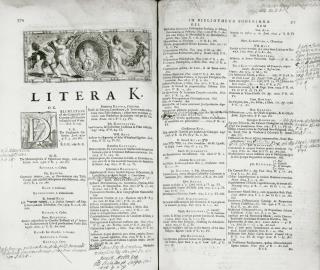 |
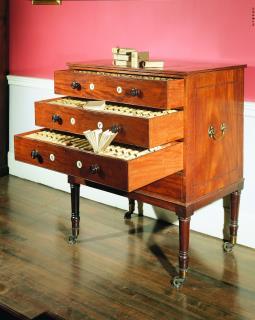 |
'Sheaf' Catalogue of the Library at Althorp [Manuscript slip catalogue], ca. 1790-1858. George John, second Earl of Spencer (1758-1834) built, over the course of nearly forty years, one of the finest private libraries ever assembled. The collection now resides at the Rylands Library at the University of Manchester. This extraordinary sheaf catalogue (precursor to the card catalogue) consists of 240 small, vellum-backed volumes of paper slips, each representing a book in Spencer's library. The purpose-built mahogany traveling chest that houses it may have accompanied Earl Spencer on his frequent book-hunting travels through Europe. A similar slip catalogue, also housed in a handsome chest, belongs to the Rylands Library.
|
The Book
Book Collecting/Curious Books/Bibliophily & Bibliomania
|
Richard de Bury. The Philobiblon of Richard de Bury. New York: Grolier Club, 1889. The Grolier Club's eighth publication was this three-volume edition of Richard de Bury's Philobiblon, the first book on bibliomania. The sumptuous covers in this set were crafted by Léon Maillard and the Club Bindery in full crushed morocco.
|
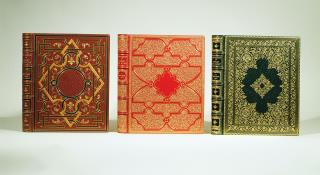 |
Writing
Illuminated Manuscripts/Calligraphy
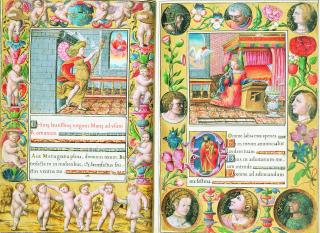 |
Book of Hours (Roman use), ca. 1545. Manuscript in Latin from France. This mid-16thc manuscript reflects the influence of the Italian Renaissance. It is illuminated in a luxurious style, with some of the illumination copied directly from woodcuts by Geoffroy Tory in printed Books of Hours published in Paris in 1527 and 1529-1530. The script is a professional humanistic book hand modeled on contemporary roman typefaces.
|
| Jean-Joseph Bernard. Calligraphic portrait of Jean-Marie Roland de la Platière, 1793. Ink on paper with watercolor wash, 74.2 x 55.5 cm. Portrait by celebrated French calligrapher portraitist, Jean-Joseph Bernard (1740-1809) depicting Jean-Marie Roland de la Platière (1734-1793), French revolutionary and leader of the Girondist party. |
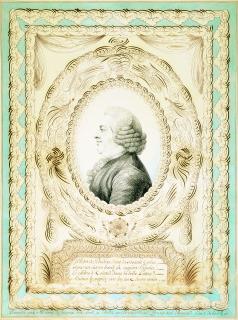 |
Typography
History of Printing/Examples of Typography/Practical Typography/Type Specimens/Paper/Presses & Processes/The Alphabet
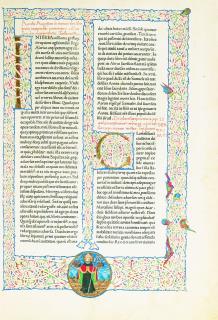 |
Konrad Sweynheim & Arnold Pannartz. St. Augustine, De civitate dei [Subiaco: Sweynheim & Pannartz, 1467]. The first printed edition of Augustine's City of God and one of four books printed by Konrad Sweynheim & Arnold Pannartz in the Benedictine monastery of Subiaco, the cradle of Italian printing. The initial leaf of text is elaborately decorated in gold and colors, with floriated borders, illuminated initials, and a roundel portrait of St. Augustine, holding a city in each hand. This is the earliest printed book in the Grolier Club Library. |
| Printers' medals. Most of the approximately 300 printers' medals in the Grolier Club Library were donated to the Club in the early part of the last century by Samuel Putnam Avery (1822-1904), Edwin B. Holden (1861-1906), and other members. The majority were created to commemorate typographers and printers, but the collection includes medals of literary figures as well. |
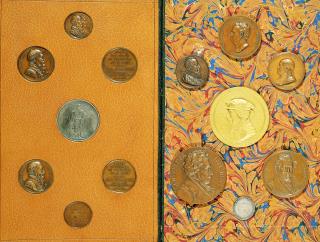 |
Illustration
Processes/Examples
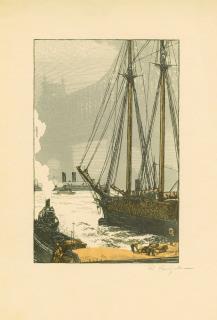 |
Color Wood Engraving. Rudolph Ruzicka, New York: A Series of Wood Engravings in Colour and a Note on Colour Printing. New York: Grolier Club, 1915. The Grolier Club's 1915 edition of Ruzicka's New York--now one of the most sought-after of Grolier Club publications--reflects the Club's keen interest in prints and printmaking, as well as affection for its birthplace. Included in the Club's archives are Ruzicka's original woodblocks as well as a set of gouache sketches for six of the ten full-page color wood engravings. |
| Utagawa Kuniyoshi. Chinese Warriors, ca. 1840. Ink and light color on paper, signed "Ichiyusai Kuniyoshi ga" and sealed. Utagawa Kuniyoshi (1798-1861) was one of the last and best known Japanese printmakers working in the traditional ukiyo-e style. He specialized in color woodblock prints depicting scenes from the Chinese vernacular tale Shuihuzhuan, or "Water Margin," which enjoyed great popularity in Japan in the early nineteenth century. Like most woodblock printmakers, Kuniyoshi was also a painter, but only a handful of his paintings survive. This superb sketch of two Chinese warriors locked in battle is a rare exception. |
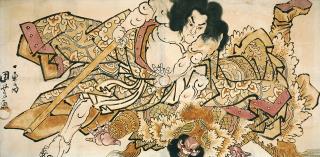 |
Bookbinding
Bookbinders/Examples of Binding/Practical Bookbinding
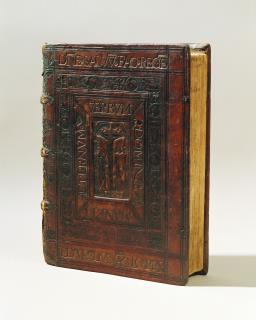 |
Edward VI Presentation Binding. On: John Bale, Illustrium maioris Brittaniae scriptorum, hoc est, Angliae, Cameriae, ac Scotiae. Ipswich: John Overton [i.e. Wesel: D. van der Straten], 1548. This copy of John Bale's bibliography of English writers retains its original royal presentation binding: calf over wooden boards, with a roll border of medallion heads and other Renaissance ornamentation surrounding a central blind-stamped panel of the Crucifixion. The inscriptions were probably added in England before the book was presented to Edward VI, who died at the age of sixteen in 1553 after a reign of only six years. |
| Paul Bonet. Paul Valéry, Paul Eluard, et al. Paris: Librairie Auguste Blaizot, 1945. Paul Bonet created bindings in an astonishingly wide range of styles, a preoccupation with lettering as a design element being the unifying and novel feature of his work. This catalogue summarizes Bonet's achievements at the height of his powers. One of fifty copies on velin d'Arches, it is bound in Bonet's characteristic irradiant style, which gives an optical illustion of three dimensions through the use of undulating gilt rules radiating from a common center. |
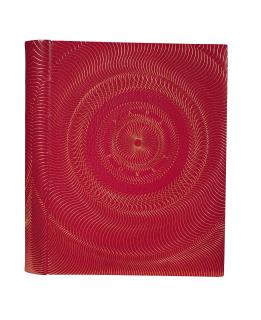 |
Ex Libris
Bookplates/Supra Libros
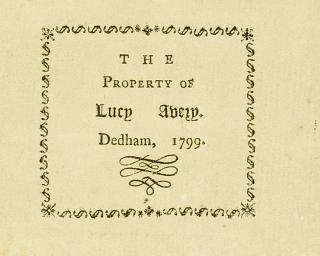 |
"The Property of Lucy Avery," Dedham [Mass.], 1799. |
| Arms of Madame de Pompadour. On: Jacques-Fabien Gautier d'agoty, Chroa-génésie ou Génération des couleurs, contre le système de Newton, 2 vols. Paris: Antoine Boudet, 1750-1751. Both covers of these volumes, bound in full red morocco in the eighteenth century, bear the gilt coat of arms of Jeanne-Antoinette Poisson Le Norman d'Étioles, marquise de Pompadour. The text, a testament to the marquise's catholic reading tastes, is a first edition of Jacques-Fabien Gautier d'Agoty's important treatise on color theory. |
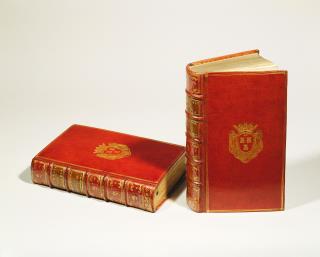 |